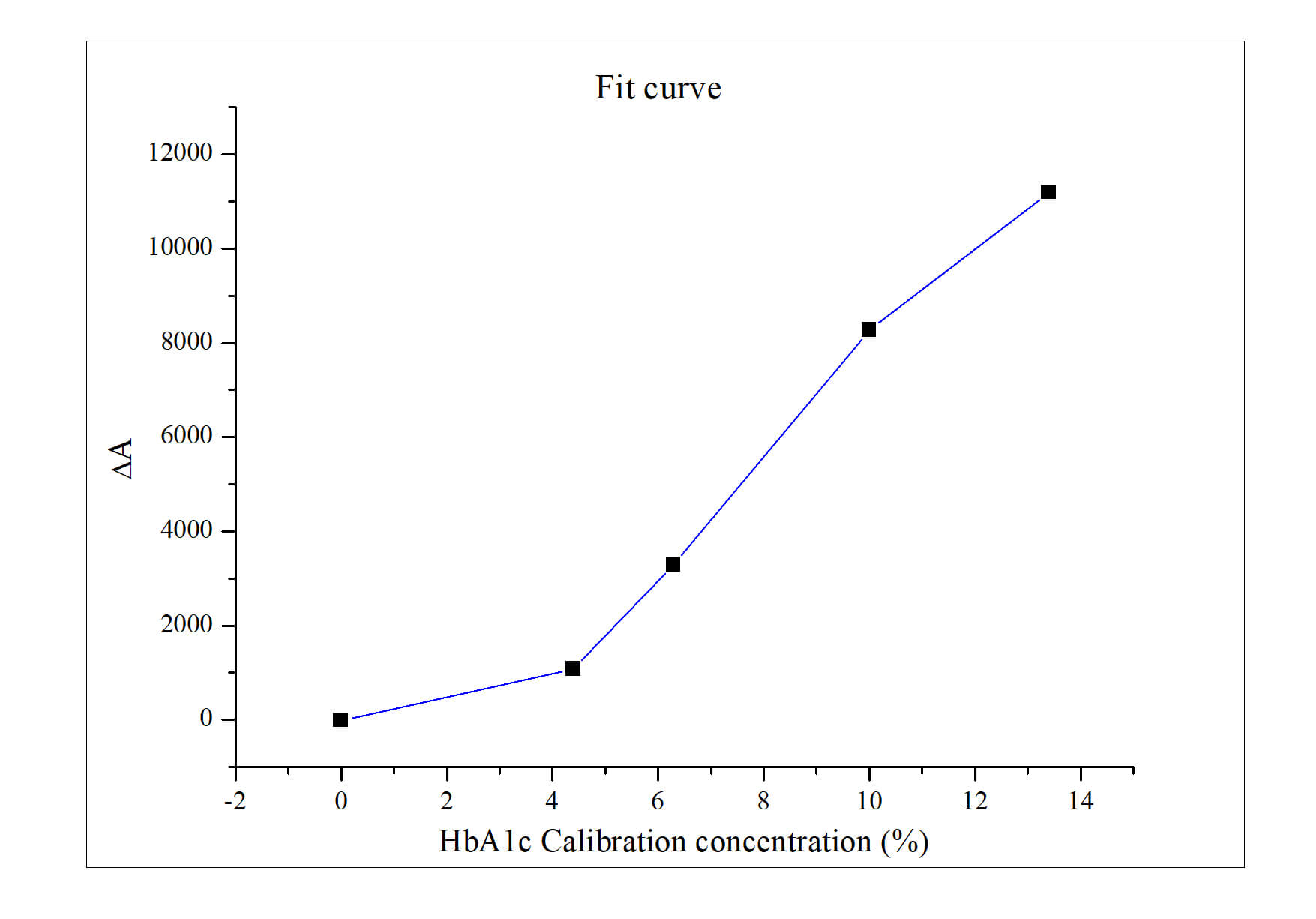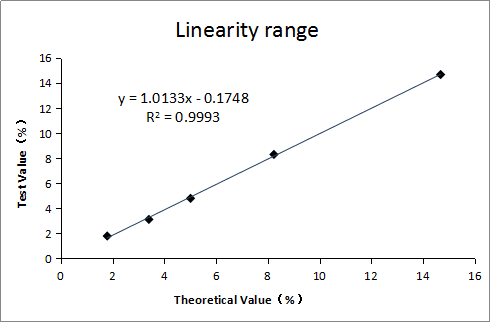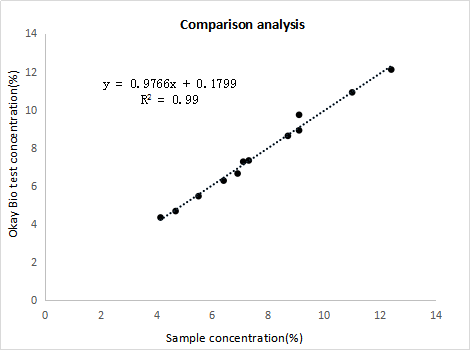Hemoglobin A1c (HbA1c)
| Description |
Mouse monoclonal antibody, cultured in vitro |
| Catalog number |
K5a2 |
K18v9 |
K17t8 |
| Applications |
Detection |
Capture |
Reagent 2 |
Epitopes |
Native HbA1c |
Hemoglobin |
Native HbA1c |
| Platforms |
Immunofluorescence, Chemiluminescence and colloidal gold |
Immunoturbidimetry |
| Buffer |
1x PBS, PH7.4 |
| Purity |
Purity>98%,purified by Protein A/G chromatography |
| Storage instructions |
Upon delivery aliquot and store at -80°C. Avoid freeze / thaw cycles. |

Antibody Product Information
Antibody Evaluation (Immunological Turbidimetry)

Fig. 1 Calibration curve
R1: Latex particals
R2: Combination of K17t8 and anti-mouse secondary antibody
Sample: HbA1c calibrator
Equipment: Hitachi 7080
Linear range
Samples: Five calibrators were prepared using Latex particals and K17t8 antibody Linear dependence > 99% with concentration between 2%-14%.
| Theoretical value (ng/ml) |
Measured value 1 |
Measured value 2 |
Average |
| 1.80 |
1.86 |
1.73 |
1.795 |
| 3.41 |
3.22 |
3.02 |
3.12 |
| 5.02 |
4.8 |
4.8 |
4.8 |
| 8.24 |
8.25 |
8.36 |
8.305 |
| 14.68 |
14.62 |
14.74 |
14.68 |
Table 1. Sample concentrations

Fig. 2 Linearity range
Repeatability
High and low values were required to repeat test over 10 times using HbA1c reagents.
CV=SD/AV×100% (CV<1% as indicated in the following table)
SD: Standard Deviation
AV: Average Value
| Target Value (%) |
SD |
AV |
CV |
| Low Value |
0.02 |
5.62 |
0.36% |
| High Value |
0.02 |
9.76 |
0.18% |
Decapping stability
| Time (d) |
1 |
8 |
15 |
22 |
29 |
| Relative deviation |
Test 1 |
0 |
1.5% |
2.61% |
1.98% |
2.06% |
| Test 2 |
0 |
3.24% |
5.47% |
4.75% |
5.81% |
Antibody Evaluation (Immunofluorescence-based)
Immunofluorescence-Based test strip was prepared with K17t8 antibody (50 Bio-Rad calibrators, Concentration: 4%-12%, R2>95%)

Fig. 3 Clinical sample analysis
Accuracy
The quality control samples with concentration of 10%-14% and 4%-9% respectively were required to repeat test three times. B= (M-T) / T×100% (B: Relative Standard Deviation, M: Average, T: Concentration)
|
Sample
(%) |
1 |
2 |
3 |
Average(%) |
RSD |
Standard |
| Batch 1 |
7.15 |
6.92 |
7.35 |
7.37 |
7.21 |
0.84% |
±15% |
| 10.28 |
10.92 |
11.03 |
9.57 |
10.51 |
2.24% |
| Batch 2 |
7.15 |
7.11 |
7.03 |
7.36 |
7.17 |
0.28% |
| 10.82 |
10.24 |
10.55 |
9.92 |
10.24 |
-5.36% |
| Batch 3 |
7.15 |
7.19 |
6.98 |
7.13 |
7.10 |
-0.70% |
| 10.82 |
10.56 |
10.79 |
10.69 |
10.68 |
-1.29% |
Repeatability
The quality control samples with concentration of 10%-14% and 4%-9% respectively were required to repeat test over 10 times. CV= (S /

) ×100% (CV < 15% as indicated in the following table)
|
Low Value
7.15% |
High Value
10.28% |
| Test 1 |
7.31 |
9.59 |
| Test 2 |
7.28 |
10.47 |
| Test 3 |
7.33 |
10.05 |
| Test 4 |
7.01 |
10.02 |
| Test 5 |
7.02 |
9.78 |
| Test 6 |
7.28 |
10.03 |
| Test 7 |
7.09 |
9.71 |
| Test 8 |
6.89 |
10.23 |
| Test 9 |
7.05 |
9.75 |
| Test 10 |
7.01 |
10.35 |
| Average (%) |
7.13 |
10.00 |
| SD |
0.158 |
0.291 |
| CV |
2.22% |
2.91% |
| Standard |
±15% |

Description
HbA1c, also known as glycated haemoglobin, is a hemoglobin-glucose combinantion formed nonenzymatically within the cell. HbA1c is a marker that measures average blood sugar levels over the past three months. It can be used clinically to access diabetes diagnose, control and treatment. Thus, HbA1c levels are recommended as one of the biochemical markers for pre-diagnose and management of diabetes, especially type 2 diabetes.
HbA1c has clinical significance on diabetes diagnosis and prognosis. It also can be used as a simple and reliable marker of insulin resistance in adults with relatively high insulin sensitivity. Compared to other indices of insulin resistance HbA1c has minimal overlap in values between healthy adults with normal glucose tolerance and patients with type 2 diabetes. Therefore, HbA1c is a reliable biomarker and an excellent indicator of insulin resistance for testing individuals for diabetes and prediabetes.

Related Products
![]() Datasheet)
Datasheet) Fig. 1 Calibration curve
Fig. 1 Calibration curve
 Fig. 3 Clinical sample analysis
Fig. 3 Clinical sample analysis ) ×100% (CV < 15% as indicated in the following table)
) ×100% (CV < 15% as indicated in the following table)